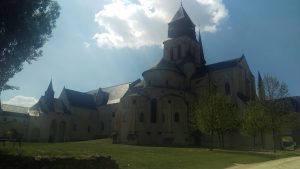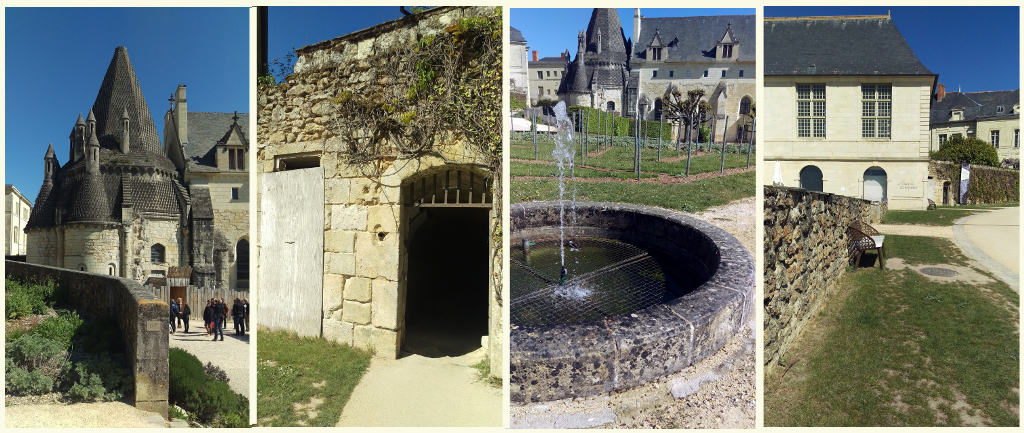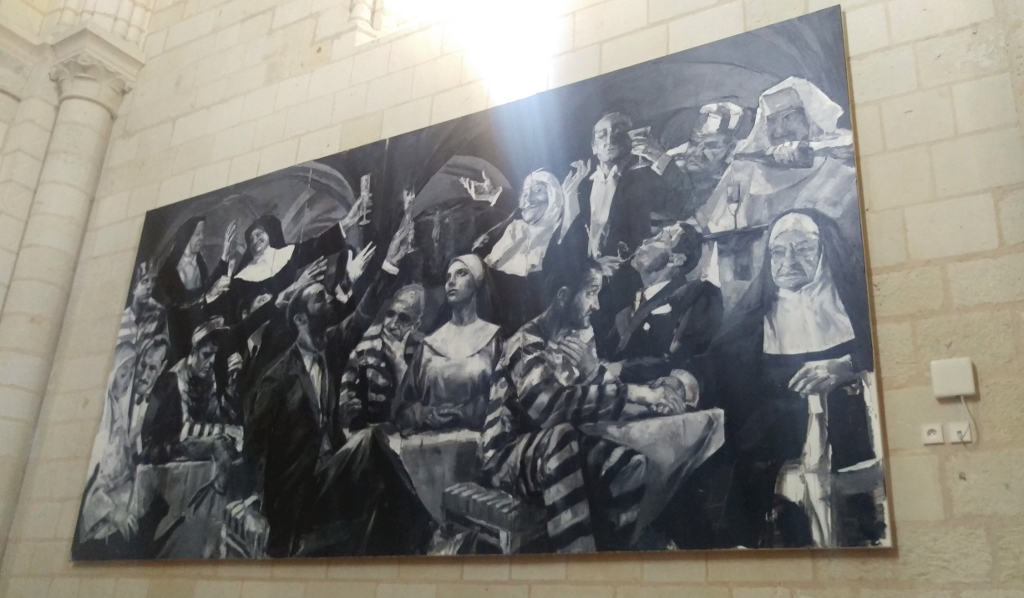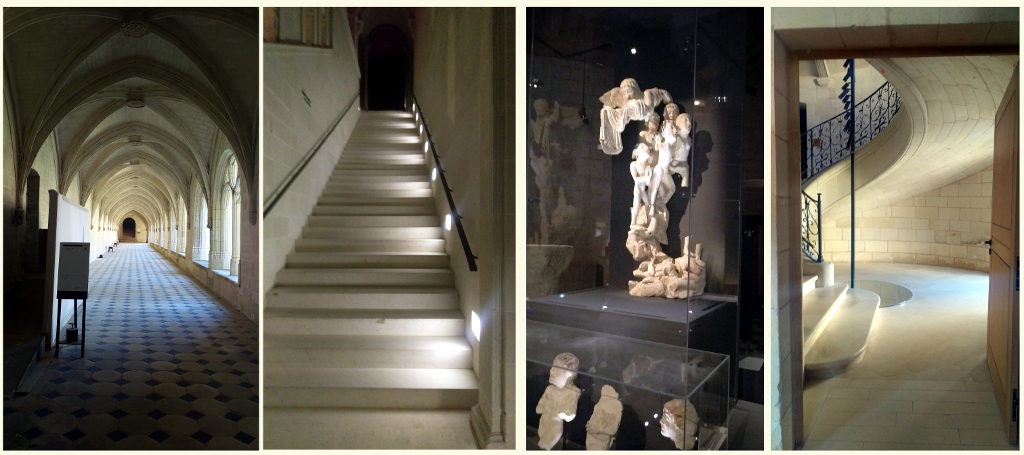This place is immense, I think to myself as I descend from the hill where the shuttle from the train station deposits us. And white. So white that it is difficult to take a proper picture in the sun. White gravel turns my black shoes dusty. White stone walls reach toward the blue sky. White steps. White walls. White arches. White like a nun's coiffe that represents part of its heritage but also belies some of its darker past. The largest Abbey in all of Europe, this is L'Abbaye Royale de Fontevraud, the Royal Abbey of Fontevraud, a UNESCO-classified historic monument in the Loire Valley of France.
 As I enter from the back gates of the private parking area, I am in awe of it all – I have not been to such a place before and do not wish to break its spell with mindless chatter to my colleagues. It seems they share my feelings – “Just look at this place” comes in almost a whisper, as if to hold onto the spell as long as possible. We have travelled here by train from Paris in a little over an hour. Away from the hustle bustle of tourists and traffic to this peaceful home to arts, culture and hospitality, we are here to learn more about the wines from the Loire Valley as part of the inaugural Loire Millésime hosted by Vins du Val de Loire.
As I enter from the back gates of the private parking area, I am in awe of it all – I have not been to such a place before and do not wish to break its spell with mindless chatter to my colleagues. It seems they share my feelings – “Just look at this place” comes in almost a whisper, as if to hold onto the spell as long as possible. We have travelled here by train from Paris in a little over an hour. Away from the hustle bustle of tourists and traffic to this peaceful home to arts, culture and hospitality, we are here to learn more about the wines from the Loire Valley as part of the inaugural Loire Millésime hosted by Vins du Val de Loire.
One of the largest monastic sites remaining from the Middle Ages, the Royal Abbey of Fontevraud sits on the border of the Anjou, Touraine and Poitou regions. Restored in concept as “The Ideal City” the four-pronged project features a range of buildings and activities specific to the site. Concerts, exhibitions and the like make up the cultural prong, space for conferences and debate, the intellectual prong. A hotel and restaurant provide for both hospitality and residential needs, a gift shop offers commercial space for local artists, souvenirs, books and locally made tea, honey and soaps. Part resort, part museum, part conference center, the project is a study in terroir – not in the sense of wine making but in the true sense of place. Its history, its beauty and its vision create a space for learning, meditating and repose. It is a place to renew, reflect and rejuvenate – especially for those of us bombarded with the 24/7 toxins of American political discourse. Just a few days at Fontevraud felt more like two weeks of true vacation. Its remarkable present strikes a balance from its complex past as both a place of reverence and a place of despair.

The Pre-Eminence of Women
Around 1101, Breton preacher Robert d’Arbrissel brought his followers to the little valley of the Fountain d’Evraud. A reformer and defender of the poor, d’Abbrissel followed Gregorian norms to establish a religious community different from most: he imposed the principle of a “double community” that divided its members over four priories, or monasteries, and formed the heart of his settlement. Unique to this community, d’Arbrissel gave pre-eminence to women. Shepherded by a series of Abbesses, it began with Petronille de Chemille in 1115 and ran smoothly for 500 years until conflict arose between the abbess Jeanne-Baptiste de Bourbon and the monks in the mid-17th century. It also became a royal necropolis, sheltering the tombs of Henri II Plantagenet, Richard Coeur de Lion (Richard the Lionheart, King of England) and his mother Alienor d’Aquitaine (Eleanor of Aquitaine), Queen Consort of France (1137 – 1152) and England (1154-1189) and Duchess of Aquitaine in her own right. Women ran France’s most powerful abbey until September 1792, when the last abbess Julie de Gondrin de Pardaillan d’Antin left Fontevraud after religious orders were abolished, male community dispersed and all abbey furniture sold. Once one of the most powerful and highly centralized religious communities, the Fontevraud order collapsed. The French Revolution destroyed and plundered the Abbey and the new Republic sold it as national property.

From Priory to Penitentiary
In 1804, Napoleon Bonaparte transformed the Abbey into a central prison, at first housing 600 men, women and children. While the Abbey prison was transformed to hold a planned 1,000 prisoners, within just five decades it grew to an overcrowded 2,000 men-only detention facility. Fontevraud prisoners manufactured buttons, gloves, chairs, nets and blankets for the army, and made linen from hemp. Operating for another 100-plus years as such, Fontevraud was considered one of the harshest prisons in France. Political prisoners received the harshest treatment. Fontevraud housed several hundred Resistance fighters, 10 of whom were reportedly shot at the abbey under orders of the Vichy Government. In his semi auto-biographic novel, The Miracle of the Rose, French novelist, playwright, poet, essayist, and political activist Jean Genet, describes the experience as though he were there, “Of all the prisons in France, Fontevrault is the most troubling.” The Pogues reference the novel in their 1990 song from the same titled album, “Hell’s Ditch.”
In 1963, the Central prison closed, and the abbey’s management shifted to the French Ministry of Culture. A historic timeline indicates the last prisoners did not leave the site until 1985, and presumably worked to complete the major restoration. Fontevraud opened to the public in 1985 as a tourist destination, and on November 30, 2000 was registered as a Loire Valley UNESCO World Heritage site.
Of the four original priories, only three remain: the Grand-Moustier (originally associated with the nuns of the choir), the Sainte-Marie Madeleine (originally the community of lay sisters) and the Saint-Lazare, whose sisters cared for lepers. The fourth, the monks’ Saint-Jean l’Habit, is said to have been dismantled stone by stone during the French Revolution.
Fontevraud Today
Walking across the grounds to the Hotel and restaurant, guests encounter soft music from an unobtrusive speaker at the corner of low hedges. Across the courtyard to the left is the iBar and restaurant. Directly in front is the hotel reception.
After major renovation, restoration and modernization, what was once the Saint-Lazare priory is now L’Hotel – the first cultural resort in France, it offers true luxury, that is neither gaudy nor superficial. Its 54 rooms feature contemporary, yet simplistic oak and iron furnishings and beautifully appointed bathrooms filled with natural honey soaps made right on the property. I loved them so much that I purchased some in the gift shop for myself and friends. Fontevraud also worked with a (local) Nantes-based company Biosense to create custom beds with headboards ideally angled for comfortable reading, with 100% natural, breathable mattresses, also available for purchase. Some rooms are singles, some doubles, others are sloping attic rooms, and others still have cathedral-type high ceilings. Lighting and acoustics create an environment perfect for meditation and reflection – but don’t let that fool you – there is modernity hidden in plain sight – with televisions behind white sliding screens, and Wi-Fi (pronounced ‘wee-fee’ in France). Plus, each guest receives an iPad upon check-in where he or she can access hotel services and learn more about the Abbey and its surroundings. The tablet can also be used to communicate with guest reception, as a remote control, a telephone, an alarm clock and gives information about guided tours. For those who seek peace away from digital, rooms invite guests to relax and reflect as each is sound-proofed with 22cm-thick (just over 8.5 inches) partitions.
Fontevraud welcomes singles, couples and families with children. Family suites, children’s menus and iPad "treasure hunts" in addition to standard tours of the grounds help make it a family affair. Children are also invited to join the chef in the kitchen before dessert where they can don an apron and chef’s hat with their name on it, to help Chef Thibaut Ruggeri create their dessert of choice, which they can then share with their family back at their table in the restaurant.
My favorite meal in Le Restaurant was the European breakfast buffet – complete with sumptuous cheeses, meats, flaky pastries and crusty breads with local honey, granola and a choice of unique teas and coffees. I could eat the local ash rind chevre every day and never grow tired of it! You can also purchase many of the Teas in the gift shop -- of course I brought some of those home to Houston as well.
The iBar
Part of the new hotel complex, the iBar is located in Saint-Lazare priory’s former chapel, and is accessible to all of Fontevraud’s visitors. It combines the historic and the innovative, a wine bar with touch screen table tops set into the furniture that allow all visitors to the Royal Abbey to access the complete history of Fontevraud while they relax with a drink. A long alter-like oak monolith serves as the bar, a horizontal counterpoint to the chapel’s vertical lines, composed of connected modules attached to the structural base carved out of age-old beams. Diffused light sets a reflective ambiance during both day and evening hours.
A connected space on the other side of the restaurant includes a fireplace, perfect for taking the chill out of a winter or Spring evening when temperatures drop. The bar and restaurant can be accessed through this space from guest reception, or from the outside courtyard.
Ways to Visit the Royal Abbey of Fontevraud
Fontevraud attracts nearly 200,000 visitors per year. Guests come as business conference attendees, individually or as families staying at the hotel, dining at the restaurant or taking daily self-guided or conducted tours of the 13 hectares of ancient buildings set within a lush landscape of gardens and trees. The property includes the Abbey church, the Romanesque kitchens, the chapter house, the cloisters and gardens with vegetables, fruit trees and flowers. Visitors can also tour the necropolis, which is a bit creepy, and not for those guests who do not enjoy low-ceilings and dark spaces. Prices are quite reasonable.
Daily Tours
The Abbey is open from 9:30 am to 6:00 pm daily January 20 through March and October through December. From April to October the Abbey stays open one extra hour to 7:00 p.m. Abbey is closed on December 25 and from January 1 through January 19. The ticket offices closes 30 minutes prior to the close of the site, and tickets may also be purchased on-line.
A self-guided tour is 11 euros for Adults and 7.50 euros for children 8 to 18. A reduced price of 7.50 euros is available for the unemployed and students with proper documentation. Children under 8 and persons with documented disabilities may enter for free, and a family with 2 adults and up to 5 children is 28 euros. For a guided tour (in French only), Audio Tour and iPad Treasure Hunt there is an additional 4.50 euros.
L’Hotel
Hotel rooms are priced per night between 139 to 190 euros, and Family rooms and suites 165 to 210 euros, depending on night of the week and season of the year. Breakfast is an additional 16 euros per person or 8 euros for children 4 to 12 years of age. Children under 4 years eat free.
Le Restaurant
Le Restaurant is open Wednesday through Saturday evening 7:30 to 9:00 p.m. (last order) and Sunday for lunch from 12:30 to 2:00 p.m. Meals are Prix Fixe menus of 3 to 8 courses are priced from 58 euros to 105 euros with wine paired at an additional cost. A children’s meal includes 3 dishes for 20 euros.
Fontevraud also hosts music concerts and shows, conferences, lectures and expositions. For more information, visit their website at http://www.fontevraud.fr
Cheers!
The WineWonkette


